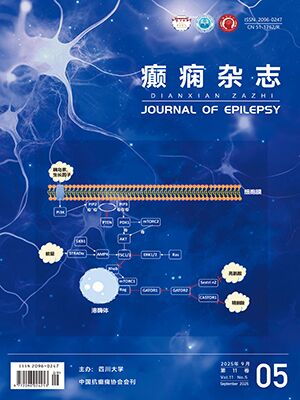| 1. |
Blumcke I,Muhlebner A. Neuropathological work-up of focalcortical dysplasias using the new ILAE consensusclassification system-practical guideline article invited by theEuro-CNS research committee. Clin Neuropathol, 2011, 30(4):164-177.
|
| 2. |
Blumcke I,Thom M,Aronica E,et al. The clinicopathologic spectrum of focal cortical dysplasias:a consensus classification proposed by an ad hoc Task Force of the ILAE Diagnostic Methods Commission. Epilepsia, 2011, 52(1):158-174.
|
| 3. |
Kuba R,Tyrlikova I,Chrastina J,et al. MRI-negative PET-positive temporal lobe epilepsy:invasive EEG findings, histopathology and postoperative outcomes. Epilepsy Behav, 2011, 22(7):537-541.
|
| 4. |
郭韬, 康进生, 郑杰, 等. 吗啡急性成瘾猫脑电图及神经病理特点. 中华神经医学杂志, 2011, 11(2):137-141.
|
| 5. |
孙基栋, 王丹丹, 梁晖, 等. 难治性癫痫172 例临床病理分析. 中华神经外科杂志, 2010, 26(6):494-496.
|
| 6. |
Knchnkhidze G,Koppelstaetter F, Unterberaer 1, et al. Midbrain-hindbrain malformations in patients with malformations of cortical development and epilepsy:a series of 220 patients. Epilepsy Research, 2013,106(1-2):181-190.
|
| 7. |
Barkovich AJ,Guerrini R,Kuzniecky RI,et al.A developmental and genetic classification for malformations of cortical development:update 2012. Brain, 2012, 135(Pt 5):1348-1369.
|
| 8. |
郭韬, 孙吉林, 昊育锦, 等. 影像学难以确诊的额叶癫痫的诊断与定位. 中华神经外科杂志, 2013, 29(12):1224-1272.
|
| 9. |
Guerrini R, Dobyns WB. Malformations of cortical development:clinical features and genetic causes.The Lancet Neurology, 2014,13(7):710-726.
|
| 10. |
Barkovich A.I,Guerrini H,Kuzniecky RI, et al. A developmentaland genetic classification for malformations of cortical development:update 2012. Brain, 2012, 135(5):1348-1369.
|
| 11. |
Bast T, Ramantani G, Seitz A, et al. Focal cortical dysplasia:prevalence, clinical presentation and epilepsy in children and adults. Acta Neurol Scand, 2006, 113(4):72-81.
|
| 12. |
盛卸晃, 宋淑亮, 梁锦锋, 等. 胶质瘢痕对神经系统损伤的保护作用. 生命的化学, 2011, 31 (2):272-275.
|
| 13. |
孙吉林, 赵文清,田中雨,等.脑软化灶FLAIR高信号与癫痫灶关系初探.中国临床医学影像杂志, 2009, 20(10):733-735.
|




